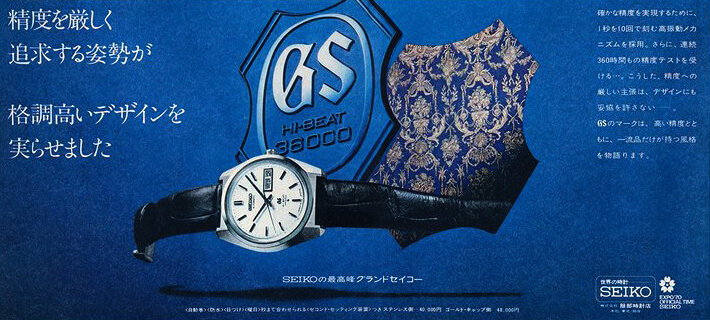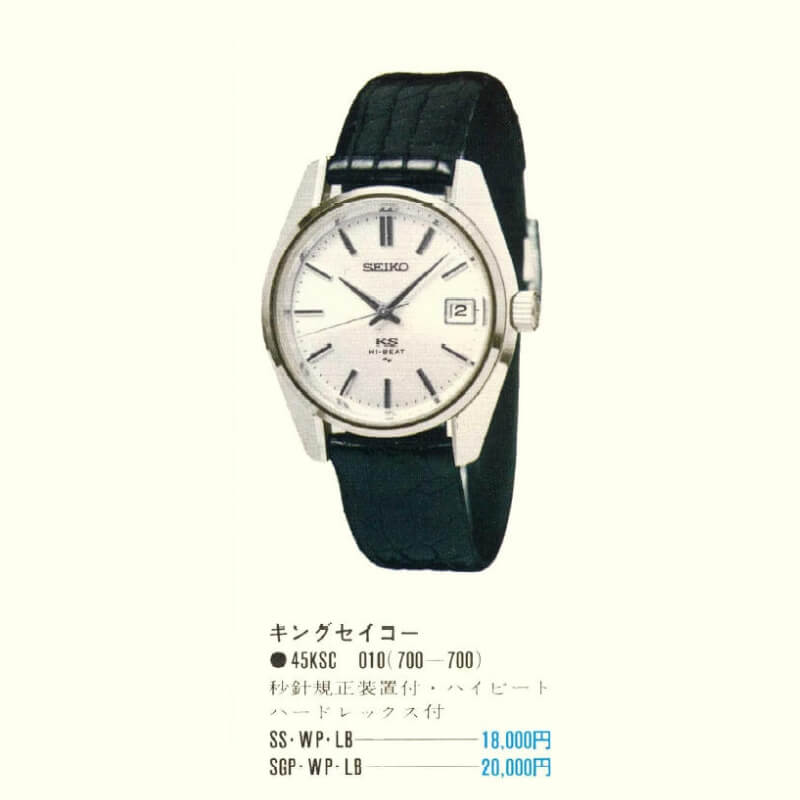Grammar
of
Design

Back in the 60's, Seiko tried to establish a completely separate design identity for its King Seiko and Grand Seiko line, the so called 'Grammar of Design'.
Experience on Desktop
G
of
D
Grammar
of
Design
Back in the 60's, Seiko tried to establish a completely separate design identity for its King Seiko and Grand Seiko line, the so called 'Grammar of Design'.
Scroll Down
© 2024 • Peachworld •
Colophon •
Credits
Sound

THE HISTORIC
BACKGROUND
By the 1950s, Seiko had already established itself as a major player in the Japanese market.
Having produced wristwatches for the domestic audience since 1913, they dominated the market by volume. However, Seiko’s international sales lagged behind. Despite the watches' quality, they failed to stand out against Swiss competitors in store displays. The designs were typically straightforward, featuring round cases, basic lugs, and plain dials. Notably, Seiko did not even have a dedicated design department until 1956.
The sixties was a decade of significant design and technical advancements
Everything changed in 1959 when Seiko hired Taro Tanako, a recent design graduate and the brand's first trained designer. Tanaka’s approach was holistic. Additionally, in the same year, Suwa Seikosha and Daini Seikosha became separate entities to promote competition and enhance the Seiko brand's overall product quality, yielding clear and impactful results.



Inspired partially by the art of gem cutting, Tanaka explored the philosophy of watch design. By 1962, he had formulated a set of guidelines for this purpose, which he named the “Grammar of Design”.
The “Grammar of Design,” distilled into few fundamental principles. First, every surface and angle on the case, dial, hands, and indices needed to be flat and geometrically precise to optimally reflect light. Second, bezels were designed as simple, two-dimensional faceted curves. Third, visual distortion was eliminated from all angles, with cases and dials mirror-finished. Lastly, every case had to be distinctive, moving away from generic round designs.

Tanaka’s design vision led to stricter manufacturing controls at Seiko, which he deemed essential to rival Swiss quality. This streamlined philosophy started with Grand Seiko and King Seiko, with the former introducing the 4420-9000 in 1967. These early models remain the clearest embodiments of Tanaka’s philosophy, solidifying their status as collectibles.


With the 44GS, Grand Seiko had found its design code and a legend was born.
From its inception, the guiding vision for its designers and engineers was to craft the "ideal" watch—one that set new benchmarks for precision, durability, and beauty in the industry.
Every step of Grand Seiko’s production process reflects the brand’s exacting standards. From development and design to manufacturing, each detail is carefully examined to achieve the highest quality. The assembly and adjustment are performed in-house, with the final inspection and shipping conducted with equal precision and care.


In 1967, Daini Seikosha (now Seiko Instruments) introduced its first Grand Seiko watch, the esteemed 44GS. That same year saw the release of the first Grand Seiko self-winding model, the 62GS, featuring a recessed crown at the 4 o’clock position to highlight the absence of the need for hand winding.

The unwavering commitment to excellence led to the creation of Grand Seiko in 1967.
the top tiers OF Seiko’s lineup
Throughout the 1960s—a decade marked by immense change—Seiko boldly competed with Western manufacturers by striving to create the world's finest watches, excelling not only in chronometry but also in exceptional design.
Grand Seiko Birth

Tanaka’s design vision led to stricter manufacturing controls at Seiko, which he deemed essential to rival Swiss quality. This streamlined philosophy started with Grand Seiko and King Seiko, with the former introducing the 4420-9000 in 1967. These early models remain the clearest embodiments of Tanaka’s philosophy, solidifying their status as collectibles.
To mitigate risk, Seiko operated two separate production facilities—Daini Seikosha and Suwa Seikosha—both of which were engaged in a strong internal competition.






KING SEIKO
& LORD MATIC
The 1960s were a pivotal decade for Seiko, marked by significant design and technical innovations, including the development of the first automatic chronograph in 1969. These advancements laid the groundwork for Seiko’s future success in the prestige watch market.
Beyond Grand Seiko, another notable series showcased the company’s mastery in creating highly accurate mechanical watches—King Seiko. Renowned not only for its precision, King Seiko also featured a bold yet elegant design that embodied the exceptional quality of its craftsmanship.
キングセイコー








ロードマチック





Lord Matic, King Seiko, and Grand Seiko lines firmly occupied the top three tiers of Seiko’s lineup
By the early 1960s, the Marvel had evolved into the Lord Marvel, a name earned due to its higher jewel count, exquisite detailing, and in some versions, a gold-filled case. However, its attempt to assert itself as a symbol of luxury was soon overshadowed by the rise of the King Seiko and Grand Seiko lines, which took the top two tiers of Seiko's product catalog. In 1967, the Lord Marvel name was revived with the introduction of the Lord Marvel 36000, Japan’s first true high-beat watch, powered by the 5740C movement running at a rapid 10 beats per second.
This revival led to the birth of the Lord Matic series, which, though positioned below King Seiko, featured a sophisticated new automatic movement and high-quality case design, clearly distinguishing it from the more common models lower in the lineup. By 1968, the Lord Matic line had gained popularity, and its 5606 movement became one of Seiko’s most widely used mechanical movements of the era. This movement also served as the foundation for higher beat variants found in many automatic King Seiko and Grand Seiko models from the early to mid-1970s.
Colophon
___________________
SOURCES
Seiko Catalog Collection
History of Grand Seiko
Seiko's Grammar of Design: the Art of Impermanence
The Art of Time: Taro Tanaka and Seiko's "Grammar of Design"
The Origin of King Seiko
Kingseiko.info
CREDITS
Concept & Design: Luca Franceschetti
3D Models optimization: Ildiko Antal
Music by Pixabay


Back to top

